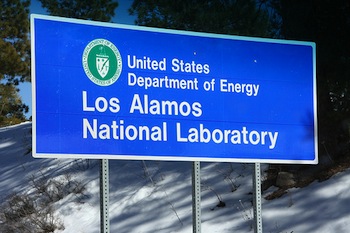 Description and Current Mission
Description and Current Mission
The Los Alamos National Laboratory (LANL), located in north-central New Mexico, was founded during World War II as a secret laboratory for the Manhattan Project. This effort led to the development of the first atomic bombs, including the "Trinity Test" on July 16, 1945, and the subsequent bombings of Hiroshima and Nagasaki, Japan. After the war, LANL continued to play a central role in the development of nuclear weapons, including the modern hydrogen bombs (H-bombs).
Los Alamos Lab FY 2025 Budget Request
In contrast to the sharp jump in nuclear weapons spending that will bring more contamination and radioactive wastes, funding for cleanup and disposition of excess facilities at the Los Alamos Lab is taking a major cut from $331.8 million in FY 2024 to $280.9 million in FY 2025 (-15.3%). https://www.energy.gov/sites/default/files/2024-03/doe-fy-2025-budget-in-brief-v2.pdf, page 69
2023 Performance Evaluation Report:
Current Role and Nuclear Weapons Missions:
Today, LANL remains deeply involved in the U.S. nuclear weapons program. Five of the seven warhead types in the planned enduring stockpile are designed by LANL. These include the B61 gravity bomb, the W76 for submarine-launched ballistic missiles, the W78 for intercontinental ballistic missiles, the W80 for sea-launched cruise missiles, and the W88 for submarine-launched ballistic missiles.
Despite discussions about mission diversification, nuclear weapons research and production continue to dominate LANL’s activities. The Department of Energy (DOE) and the National Nuclear Security Administration (NNSA) have consistently allocated the majority of LANL’s budget to these programs. For FY 2024, LANL received a substantial increase in funding for plutonium pit production, a critical component of nuclear weapons. This funding was raised to $1.76 billion, reflecting a 14% increase from the previous year.
LANL’s primary nuclear weapons missions include:
- Research, design, development, and simulated testing of nuclear weapons.
- Life Extension Programs for nuclear weapons.
- Limited production of plutonium pits, currently authorized for up to 20 per year, but with significant future expansion planned.
- Manufacture of nuclear weapon detonators.
- Research and development related to enriched and depleted uranium components.
- Assessment and certification of the existing nuclear stockpile.
- Tritium and high explosives research and development.
- Explosive hydrodynamic testing of surrogate plutonium pits.
Plutonium Complex at LANL:
LANL’s Technical Area-55 (TA-55) hosts Plutonium Facility-4 (PF-4), the only fully operational plutonium pit production facility in the U.S. These plutonium pits are vital as the "primary" stage in modern nuclear weapons, setting off the fusion reaction in the "secondary" stage. The expansion of pit production has locked LANL into a continued focus on nuclear weapons rather than diversifying to address contemporary security threats, such as nuclear proliferation and climate change.
Socioeconomic and Environmental Impact:
LANL’s presence has significantly influenced the local economy and demographics. Los Alamos County is one of the wealthiest counties in the United States, with a population that is predominantly white, contrasting sharply with New Mexico's overall demographics and high poverty rates. Despite LANL’s economic impact, New Mexico ranks low in per capita income and has a high poverty rate, especially among children.
Moreover, LANL's operations have left a legacy of environmental contamination, particularly from Cold War-era activities. Cleanup costs are estimated to range from $2 billion to over $30 billion, depending on the level of remediation approved by the New Mexico Environment Department. Critics argue that funds should prioritize cleaning up existing contamination rather than expanding nuclear weapons facilities.
Overview on the Future of LANL:
The ongoing expansion of plutonium pit production at LANL has been criticized by nuclear watchdogs and experts. They argue that increasing pit production may undermine efforts to reduce the global nuclear threat and could lead to significant environmental and financial costs. Critics also question the need for new pits, given that existing ones have been shown to remain reliable for at least a century. Additionally, there are concerns that the focus on nuclear weapons detracts from addressing more pressing security challenges like climate change and global health issues.
The debate over LANL’s mission reflects broader tensions between national security priorities and the need for sustainable, diversified research that addresses contemporary global challenges.

